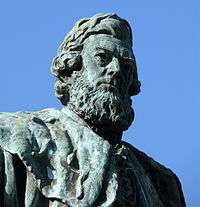William Chambers (publisher)
| The Right Honourable William Chambers of Glenormiston | |
|---|---|
|
Statue erected in memory of William Chambers of Glenormiston. It faces the National Museum of Scotland in Chambers Street, Edinburgh. | |
| Lord Provost of Edinburgh | |
|
In office 1865–1869 | |
| Monarch | Queen Victoria |
| Preceded by | Charles Lawson of Borthwick Hall |
| Succeeded by | William Law |
| Personal details | |
| Born |
16 April 1800 Peebles, United Kingdom |
| Died | 20 May 1883 |
| Nationality | British |

William Chambers of Glenormiston or William Chambers FRSE LLD (16 April 1800[1] – 20 May 1883) was a Scottish publisher and politician, the brother (and business partner) of Robert Chambers. The brothers were influential in the mid-19th century, in both scientific and political circles.
Biography
Chambers was born in Peebles and moved to Edinburgh in 1814 to work in the book-selling trade and soon branched out into printing. He opened his own bookshop in 1819 on Broughton Street, a historical street absorbed by Edinburgh's New Town.[2][3] and founded the publishing firm of W. & R. Chambers Publishers in 1832. He was a keen advocate of popular education and his firm was a pioneer in the use of industrial technologies of publishing to make print available cheaply.[4] With his younger brother, Robert Chambers, he produced books and periodicals of Scottish interest, such as Gazetteer of Scotland. They also made money in promulgating the many new science discoveries as the modern world emerged from prior modes of thinking in such periodicals as the Edinburgh Journal (see below). Their publishing business prospered, and in 1859 William founded a museum and art gallery in Peebles. The brothers collaborated on the publication of Chambers Encyclopaedia between 1860 and 1868.
He was elected a Fellow of the Royal Society of Edinburgh in 1860, his proposer being John Shank More.[5] His address was then given as 13 Chester Street, a large townhouse in Edinburgh's west end.[6]
As Lord Provost of Edinburgh from 1865 to 1869, Chambers was responsible for the restoration of St Giles Cathedral and other major town planning exercises, including the creation of Jeffrey Street, St Marys Street and Blackfriars Street. These streets were all created under the City Improvement Act of 1866, including one named in his memory: (Chambers Street) and here in its centre stands a statue to him, by local sculptor John Rhind[7] with low-relief copper panels on the base by William Shirreffs.[8]
Chambers is buried in Peebles Cemetery.[9]
Memorials
A memorial stained glass window was erected in the centre of the north aisle of St Giles Cathedral in his memory. A smaller window to his brother Robert stands to its side.
W. & R. Chambers
In the beginning of 1832 William Chambers started a weekly publication under the title of Chambers's Edinburgh Journal, (known since 1854 as Chambers's Journal of Literature, Science and Arts[10]), which speedily attained a large circulation (84,000), and to which his younger brother Robert Chambers was at first only a contributor. After fourteen issues had appeared, Robert became associated with his brother as joint editor, and his collaboration may have contributed more than anything else to the success of the Journal. From September 1832 the two brothers formed the book publishing firm of W. & R. Chambers Publishers. The firm would eventually become part of Chambers Harrap Publishers in the late twentieth century.
Among the other numerous works of which Robert was in whole or in part the author, the Biographical Dictionary of Eminent Scotsmen (4 vols., Glasgow, 1832–1835), the Cyclopædia of English Literature (1844), the Life and Works of Robert Burns (4 vols., 1851), Ancient Sea Margins (1848), the Domestic Annals of Scotland (1859–1861) and the Book of Days (2 vols., 1862–1864) were the most important.
In culture
He was played by Christopher Lee in the 2005 feature film The Adventures of Greyfriars Bobby.
See also
- Chambers Harrap Publishers
- Chambers Institution, Peebles, Scottish Borders, an arts centre, museum and library which bears W. Chambers' name.
References
- ↑
 Chisholm, Hugh, ed. (1911). "Chambers, Robert". Encyclopædia Britannica. 5 (11th ed.). Cambridge University Press. p. 821.
Chisholm, Hugh, ed. (1911). "Chambers, Robert". Encyclopædia Britannica. 5 (11th ed.). Cambridge University Press. p. 821. - ↑ http://digital.nls.uk/directories/browse/pageturner.cfm?id=83400015&mode=transcription
- ↑ per Wikipedia at Chambers Harrap Publishers, 1st publication date, retrieval date: 2009-03-09
- ↑ Fyfe, Aileen (2012) Steam-Powered Knowledge: William Chambers and the Business of Publishing, 1820-1860 Chicago: University of Chicago Press
- ↑ https://www.royalsoced.org.uk/cms/files/fellows/biographical_index/fells_indexp1.pdf
- ↑ http://journals.cambridge.org/action/displayAbstract?fromPage=online&aid=8367042
- ↑ Mcwilliam, Colin. Buildings of Scotland: Edinburgh.
- ↑ http://www.glasgowsculpture.com/pg_biography.php?sub=shirreffs_w
- ↑ https://www.royalsoced.org.uk/cms/files/fellows/biographical_index/fells_indexp1.pdf
- ↑ "sale offering of, bound collection". Retrieved 2009-03-09.
as of the accessdate, this site was selling a bound collected as a hardcopy of 1856's "Chambers Journal of Literature, Science and Arts" (no "Apostrophy-S")
- Papers for the people 1850 12 vols.
Further reading
- Fyfe, Aileen (2012). Steam-Powered Knowledge: William Chambers and the Business of Publishing, 1820-1860. Chicago, London: University of Chicago Press. ISBN 978-0-226-27651-9.
External links
- Works by William Chambers at Project Gutenberg
- Works by or about William Chambers at Internet Archive
